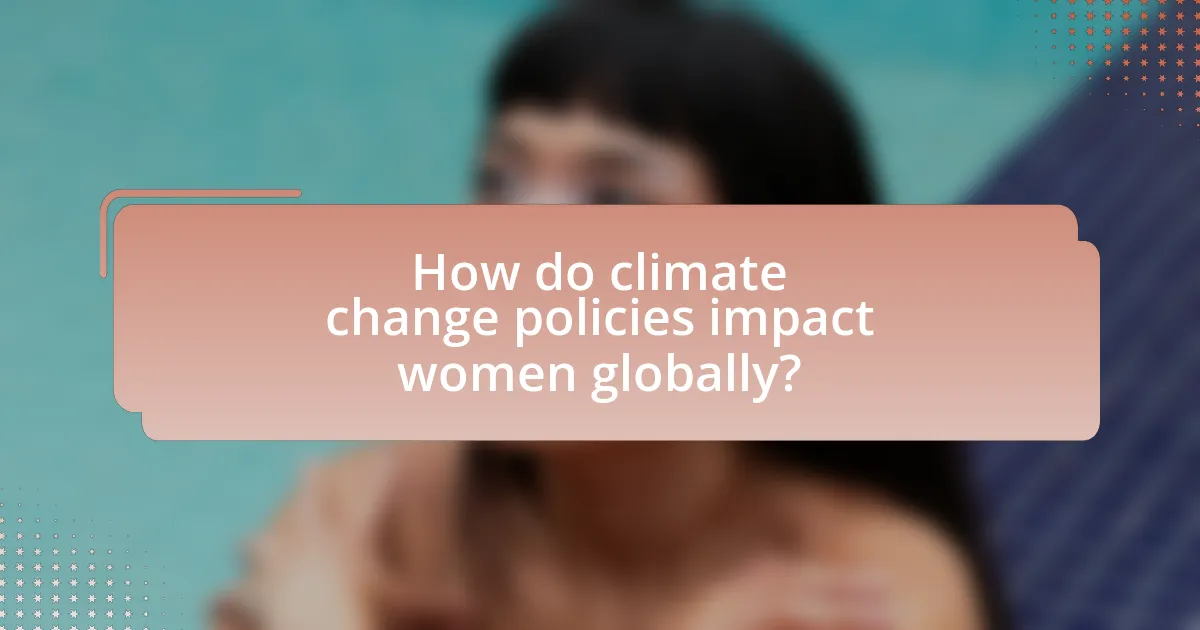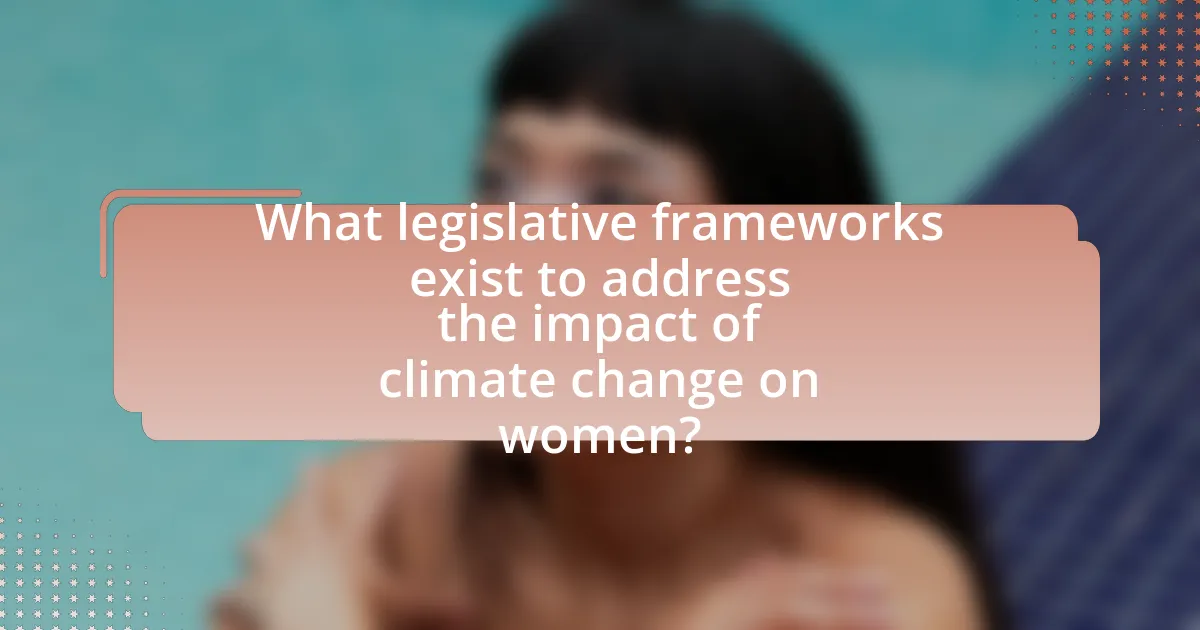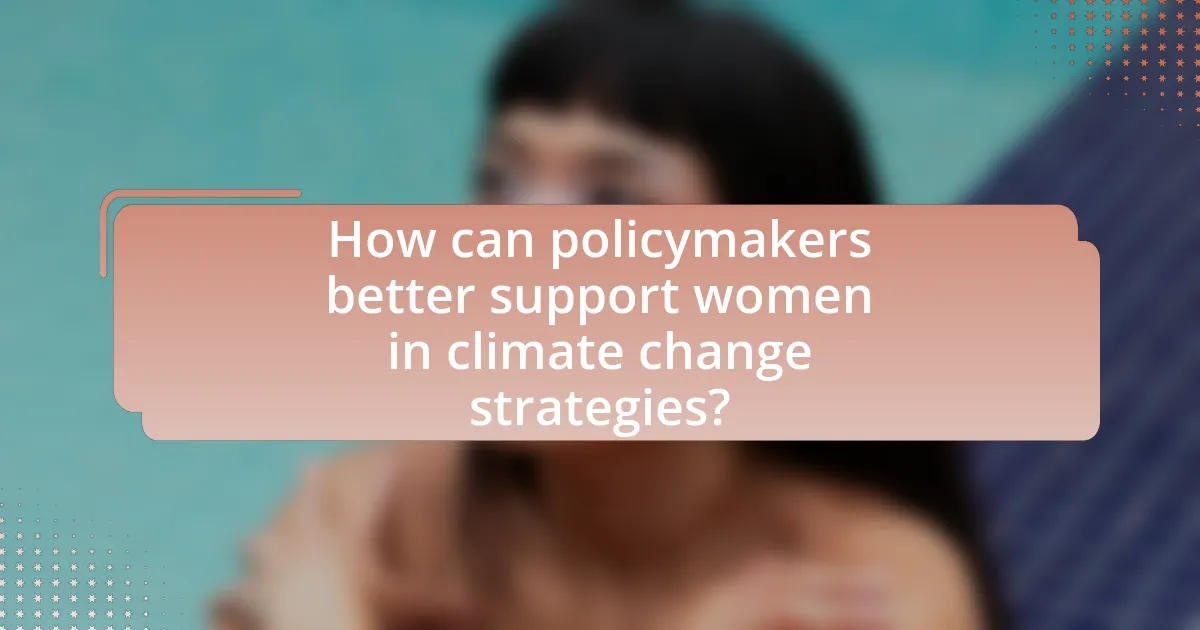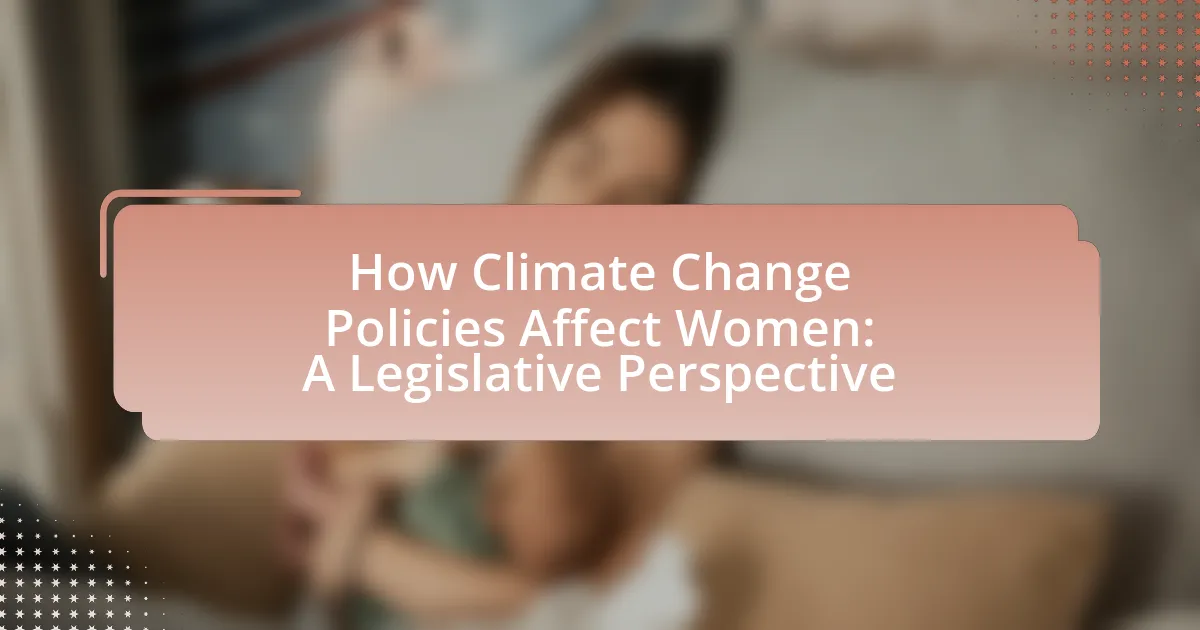The article examines the impact of climate change policies on women globally, highlighting how these policies exacerbate existing gender inequalities and limit women’s access to resources and decision-making. It discusses key climate agreements, such as the Paris Agreement, that emphasize gender equality and the need for gender-responsive approaches in national adaptation plans. The article also explores regional differences in policy implementation, specific challenges faced by women, and the importance of integrating gender perspectives into climate legislation to enhance effectiveness and equity. Additionally, it outlines local initiatives, funding opportunities, and practical steps for improving legislative responses to women’s needs in the context of climate change.

How do climate change policies impact women globally?
Climate change policies impact women globally by exacerbating existing gender inequalities and limiting their access to resources and decision-making processes. Women, particularly in developing countries, often bear the brunt of climate change effects due to their roles in agriculture and household management, which are heavily influenced by environmental changes. For instance, a study by the United Nations Framework Convention on Climate Change (UNFCCC) highlights that women represent 43% of the agricultural labor force in developing countries, making them vulnerable to climate-related disruptions. Furthermore, climate policies that do not consider gender-specific needs can lead to inadequate support for women, hindering their economic empowerment and resilience. This is evidenced by the fact that women are less likely to receive financial assistance for climate adaptation projects, which can further entrench poverty and limit their ability to cope with climate impacts.
What are the key climate change policies affecting women?
Key climate change policies affecting women include the Paris Agreement, which emphasizes gender equality in climate action, and national adaptation plans that integrate gender considerations. The Paris Agreement, adopted in 2015, mandates that countries consider the differentiated impacts of climate change on women, recognizing their unique vulnerabilities and roles in climate resilience. Additionally, many countries’ national adaptation plans incorporate gender-responsive approaches, ensuring that women’s voices and needs are included in decision-making processes. Research indicates that women are disproportionately affected by climate change, with studies showing that they represent 70% of the world’s poor, making gender-sensitive policies essential for effective climate action.
How do these policies differ across various regions?
Climate change policies differ significantly across various regions due to factors such as economic development, cultural values, and governance structures. For instance, developed regions like Europe often implement comprehensive climate policies that include gender considerations, aiming to empower women through initiatives like renewable energy projects and sustainable agriculture. In contrast, developing regions may prioritize immediate economic growth over environmental concerns, leading to policies that inadequately address women’s roles in climate adaptation and mitigation. Evidence from the United Nations Framework Convention on Climate Change (UNFCCC) highlights that countries with gender-responsive climate policies, such as Sweden and Germany, report better outcomes for women in terms of participation and benefits from climate initiatives compared to countries with less inclusive approaches, such as those in parts of Africa and Asia where gender disparities remain pronounced.
What specific challenges do women face due to these policies?
Women face specific challenges due to climate change policies, including increased economic vulnerability and limited access to resources. These policies often overlook the unique needs of women, leading to disparities in funding and support for adaptation measures. For instance, women are disproportionately affected by climate-related disasters, as they typically have less access to financial resources and decision-making power, which exacerbates their economic instability. According to the United Nations, women represent 70% of the world’s poor, making them more susceptible to the impacts of climate change and related policies. Additionally, gender-blind policies can hinder women’s participation in climate action, limiting their ability to influence decisions that affect their livelihoods and communities.
Why is it important to consider gender in climate change legislation?
Considering gender in climate change legislation is crucial because women and men experience the impacts of climate change differently due to existing social, economic, and cultural inequalities. Women, particularly in developing countries, often bear the brunt of climate-related challenges, such as food insecurity and displacement, as they are typically responsible for managing household resources. Research indicates that when women are included in climate decision-making processes, the effectiveness of climate policies improves, leading to better outcomes for communities. For instance, a study by the United Nations Development Programme found that women’s participation in climate adaptation initiatives can enhance resilience and sustainability, demonstrating that gender-inclusive policies are not only equitable but also essential for effective climate action.
How does gender inequality influence the effectiveness of climate policies?
Gender inequality significantly undermines the effectiveness of climate policies by limiting women’s participation in decision-making processes and access to resources. Research indicates that women often possess unique knowledge and skills related to environmental management, yet they are frequently excluded from leadership roles in climate policy development. For instance, a study by the United Nations Development Programme found that countries with higher gender equality are more likely to implement effective climate policies, as inclusive governance leads to more comprehensive and sustainable solutions. Additionally, when women are empowered, they can contribute to innovative approaches in climate adaptation and mitigation, enhancing overall policy outcomes.
What role do women play in climate change mitigation and adaptation?
Women play a crucial role in climate change mitigation and adaptation by actively participating in decision-making processes, implementing sustainable practices, and leading community initiatives. Research indicates that women are often primary managers of natural resources, which positions them uniquely to influence environmental conservation and sustainable development. For instance, a study by the Food and Agriculture Organization (FAO) highlights that women contribute to 43% of the agricultural labor force in developing countries, making their involvement essential for implementing climate-resilient agricultural practices. Furthermore, women’s leadership in grassroots organizations has been shown to enhance community resilience to climate impacts, as evidenced by initiatives in countries like Bangladesh, where women-led groups have successfully adapted to flooding through innovative local strategies.

What legislative frameworks exist to address the impact of climate change on women?
Legislative frameworks addressing the impact of climate change on women include the United Nations Framework Convention on Climate Change (UNFCCC), the Paris Agreement, and various national policies that integrate gender considerations into climate action. The UNFCCC emphasizes gender equality and women’s empowerment in climate policies, while the Paris Agreement encourages countries to consider gender-responsive approaches in their climate action plans. Additionally, many countries have developed national adaptation plans and climate action strategies that specifically address the vulnerabilities of women to climate change, recognizing their unique roles and contributions in environmental management. For instance, the Gender Action Plan adopted at the UNFCCC’s 25th Conference of the Parties outlines specific actions to enhance women’s participation in climate decision-making processes.
How do international agreements incorporate gender perspectives?
International agreements incorporate gender perspectives by explicitly recognizing the different impacts of climate change on women and men, and by promoting gender equality in policy frameworks. For instance, the Paris Agreement encourages parties to consider gender-responsive approaches in their climate actions, acknowledging that women often face greater vulnerabilities due to social, economic, and cultural factors. Additionally, the United Nations Framework Convention on Climate Change (UNFCCC) has established a Gender Action Plan, which aims to enhance the participation of women in climate decision-making processes and ensure that gender considerations are integrated into all aspects of climate policy. This integration is supported by evidence showing that gender-inclusive policies lead to more effective climate action and sustainable development outcomes.
What are the strengths and weaknesses of these agreements?
The strengths of climate change agreements include their potential to promote gender equality by integrating women’s perspectives and needs into policy frameworks, which can lead to more effective and inclusive climate action. For instance, agreements like the Paris Agreement encourage countries to consider gender-responsive approaches, thereby enhancing women’s participation in decision-making processes related to climate change.
Conversely, the weaknesses of these agreements often lie in their implementation and enforcement. Many countries may lack the political will or resources to fully integrate gender considerations into their climate policies, resulting in a gap between the commitments made and the actual outcomes. Additionally, the vague language in some agreements can lead to inconsistent application and monitoring of gender-related provisions, undermining their effectiveness in addressing the specific impacts of climate change on women.
How do national policies align with international commitments?
National policies align with international commitments by integrating global agreements into domestic legislation and frameworks. For instance, countries that ratify the Paris Agreement commit to reducing greenhouse gas emissions, which often leads to the development of national climate action plans that reflect these targets. This alignment is evidenced by the incorporation of Sustainable Development Goals (SDGs) into national strategies, ensuring that local policies address international objectives such as gender equality and climate resilience. Furthermore, countries often report their progress on these commitments through mechanisms like the United Nations Framework Convention on Climate Change (UNFCCC), demonstrating accountability and adherence to international standards.
What local initiatives are in place to support women affected by climate change?
Local initiatives supporting women affected by climate change include community-based programs that focus on sustainable agriculture, access to clean water, and financial literacy. For instance, organizations like Women for Climate Action in various regions provide training in climate-resilient farming techniques, enabling women to adapt to changing environmental conditions. Additionally, initiatives such as microfinance programs specifically target women, allowing them to invest in sustainable practices and improve their economic resilience. These programs are crucial as women often bear the brunt of climate impacts, with studies indicating that women in developing countries are 14 times more likely than men to die during climate-related disasters.
How do grassroots movements influence climate policy?
Grassroots movements influence climate policy by mobilizing public support, raising awareness, and advocating for systemic change. These movements often highlight local environmental issues, which can lead to increased political pressure on policymakers. For instance, the global climate strikes initiated by youth activists in 2018 galvanized millions, prompting governments to prioritize climate action in their agendas. Research indicates that grassroots activism can lead to significant policy shifts; for example, the Sunrise Movement’s advocacy contributed to the introduction of the Green New Deal in the U.S. Congress. This demonstrates that grassroots efforts can effectively shape legislative priorities and influence climate policy outcomes.
What best practices can be identified from successful local initiatives?
Successful local initiatives often incorporate community engagement, collaboration among stakeholders, and data-driven decision-making as best practices. Community engagement ensures that the voices of women and marginalized groups are included, leading to more equitable climate policies. Collaboration among stakeholders, including local governments, NGOs, and community organizations, fosters resource sharing and enhances the effectiveness of initiatives. Data-driven decision-making allows for the assessment of local needs and the impact of policies, ensuring that interventions are tailored and effective. For instance, the City of San Francisco’s Climate Action Strategy involved extensive community input and partnerships, resulting in policies that effectively address the unique challenges faced by women in climate resilience.

How can policymakers better support women in climate change strategies?
Policymakers can better support women in climate change strategies by ensuring their active participation in decision-making processes and providing targeted funding for women-led initiatives. Research indicates that women are disproportionately affected by climate change, yet they play a crucial role in developing sustainable solutions. For instance, the United Nations Framework Convention on Climate Change emphasizes the importance of gender-responsive policies, which can enhance resilience and adaptive capacity among women. By integrating gender perspectives into climate policies and allocating resources specifically for women’s empowerment, policymakers can create more effective and equitable climate strategies.
What strategies can be implemented to enhance women’s participation in climate policy?
To enhance women’s participation in climate policy, implementing targeted capacity-building programs is essential. These programs should focus on educating women about climate issues, policy-making processes, and advocacy skills, thereby empowering them to engage effectively. Research indicates that when women are involved in decision-making, climate policies are more comprehensive and effective; for instance, a study by the World Bank found that women’s participation in environmental governance leads to better outcomes for communities. Additionally, establishing mentorship networks connecting experienced female leaders with emerging women in the field can facilitate knowledge transfer and support. Furthermore, ensuring gender-responsive budgeting in climate initiatives can allocate resources specifically for women’s involvement, thereby promoting equity and representation in climate policy discussions.
How can education and awareness campaigns empower women in this context?
Education and awareness campaigns can empower women in the context of climate change policies by providing them with critical knowledge and skills necessary to engage in decision-making processes. These campaigns can raise awareness about the specific impacts of climate change on women, such as increased vulnerability to natural disasters and economic instability, thereby fostering a sense of agency. For instance, studies have shown that when women are educated about climate resilience strategies, they are more likely to participate in community planning and advocacy efforts, leading to more inclusive and effective climate policies. Furthermore, targeted education initiatives can enhance women’s access to resources and technologies, enabling them to adapt to climate challenges and contribute to sustainable practices.
What funding opportunities exist to support women-led climate initiatives?
Funding opportunities for women-led climate initiatives include grants from organizations such as the Global Environment Facility, which allocates resources specifically for gender-responsive climate projects. Additionally, the Women’s Environmental Network offers funding and support for women-led initiatives that address climate change. The United Nations Development Programme also provides funding through its Gender and Climate Change program, which focuses on empowering women in climate action. These funding sources are designed to enhance women’s participation in climate solutions and ensure that their perspectives are integrated into environmental policies.
What are the potential benefits of integrating gender perspectives in climate policies?
Integrating gender perspectives in climate policies can enhance the effectiveness and equity of climate action. By recognizing the different vulnerabilities and capacities of women and men, policies can be tailored to address specific needs, leading to more inclusive and sustainable outcomes. For instance, research by the United Nations Framework Convention on Climate Change (UNFCCC) indicates that women often play crucial roles in managing natural resources and are key to community resilience. Therefore, their involvement in decision-making processes can improve resource management and increase community adaptation to climate impacts. Additionally, gender-responsive policies can promote social justice, ensuring that both women and men benefit from climate initiatives, ultimately fostering broader support for climate action.
How can gender-sensitive policies lead to more effective climate action?
Gender-sensitive policies can lead to more effective climate action by ensuring that the unique needs and contributions of women are recognized and integrated into climate strategies. Research indicates that women often play crucial roles in resource management and are disproportionately affected by climate change impacts, which means their involvement can enhance the effectiveness of climate initiatives. For instance, the United Nations Framework Convention on Climate Change (UNFCCC) emphasizes that gender-responsive approaches can improve decision-making processes and outcomes, as women bring diverse perspectives and solutions to environmental challenges. Furthermore, studies show that countries with gender-inclusive policies tend to have better climate resilience and adaptation strategies, as they leverage the knowledge and skills of women in agriculture, water management, and community organization.
What long-term impacts can be expected from prioritizing women’s needs in climate legislation?
Prioritizing women’s needs in climate legislation can lead to enhanced resilience and adaptive capacity in communities. By integrating women’s perspectives and experiences, legislation can address specific vulnerabilities, resulting in more effective climate adaptation strategies. Research indicates that when women are involved in decision-making processes, communities are better equipped to manage climate risks, as women often possess unique knowledge about local ecosystems and resource management. For instance, a study by the World Bank found that women’s participation in climate-related decision-making can improve agricultural productivity by up to 20%, demonstrating the tangible benefits of prioritizing their needs in policy frameworks.
What practical steps can be taken to improve the legislative response to women’s needs in climate change?
To improve the legislative response to women’s needs in climate change, policymakers should integrate gender analysis into climate legislation. This involves assessing how climate policies impact women differently than men, ensuring that women’s voices are included in decision-making processes, and allocating resources specifically for women’s climate adaptation and mitigation efforts. For example, the United Nations Framework Convention on Climate Change emphasizes the importance of gender-responsive approaches, highlighting that women are disproportionately affected by climate change due to existing social inequalities. By implementing gender-sensitive policies, such as providing training and resources for women in agriculture and disaster risk management, legislation can better address the unique challenges women face in the context of climate change.


